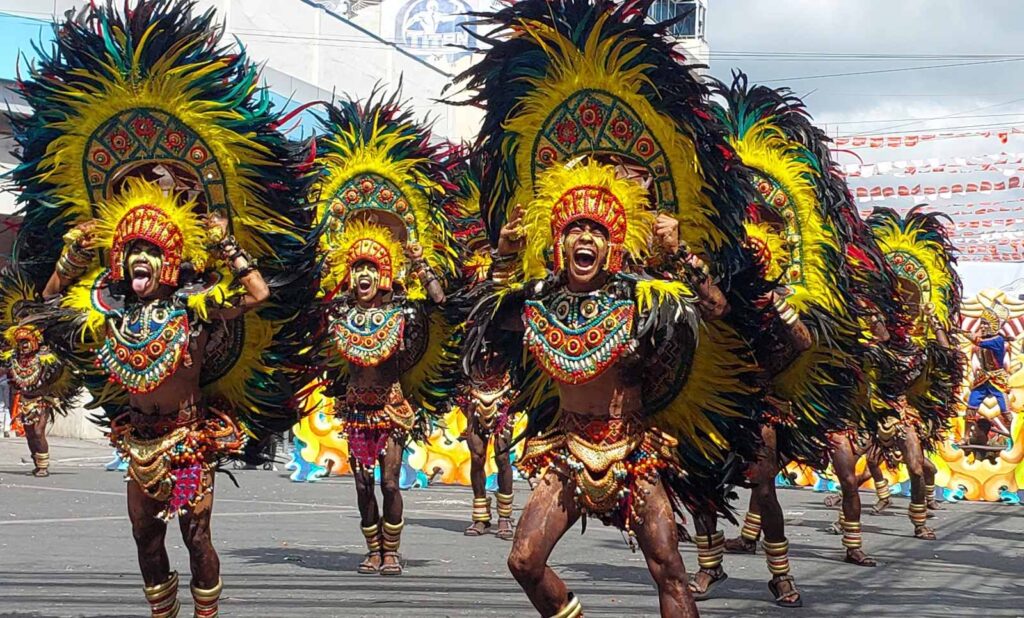Dances of the Babaylans in honor of the Sto.Nino
The confluence of pre-colonial indigenous culture and Christianity is shown by the special roles of Babaylans during most performances honoring the Sto.Nino.
The Sto. Niño is venerated all over the country with annual festivals celebrated every last two weekends of January through special masses, dances and processions attracting millions of devotees and tourists.
The main religious festivals are the Ati-Atihan of Kalibo, Aklan, Dinagyang of Iloilo, and Dinagsa of Cadiz City, and Sinulog of Cebu.
Along with the Babaylans, the rites are usually performed with instrumental music, chanting, and often dancing as part of communal life cycles. They serve as a popular medium of dramatic expression and entertainment that reflects the people’s nature, culture and aspirations.
Babaylan refers to the pre-colonial Philippine tradition of mystical healers whose spiritual connectedness was a source of political and social power.
They were mostly women but there were also feminized men (asog or bayok) who were known for their love and desire to serve their communities in achieving justice and peace.
The leadership roles of babaylans are multi-fold: warrior, healer, priestess and sage.
In the governance structure that included the datu (tribal chief), the bayani/bagani (warrior), and the panday (crafts person), no decisions were usually made without consulting the Babaylan.
Babaylans serve as intermediaries between spiritual and material worlds who are specialized in communicating, appeasing, or harnessing the spirits of the dead and the spirits of nature.
With powers of healing, herbalism, divination, and sorcery, babaylans were believed to have spirit guides, by which they could contact and interact with the spirits and deities (anito or diwata) and the spirit world.
The babaylan, who is gifted to heal the spirit and the body, speaks in a mysterious language “intelligible” to the gods, offers the sacrifices, and dances in a trance.
The ritualistic dances reflect spiritual and social life that are closely attuned to nature, believing in the spirits that keep their environment and themselves alive.
Some babaylans were political activist who resisted Spanish rule and conversion who led open revolts.
Filipino Catholics are known for having sincere, enormous, and extreme expressions of piety considering that the country is the third-largest Catholic population in the world.
The colorful culture of the Philippines is best seen through the vibrant festivals which are essentially fusions of Catholic and secular beliefs and practices that reflected the faith most Filipinos already had before the Spanish contact in 1521.
Festivals are prime manifestations of the Filipino’s fervent devotion and faith characterized by history, artistry, creativity, and passion.
Even if the Santo Nino statue is a diminutive figure, Jesus is depicted as a small king with royal regalia: crown, red cloak of intricate embroidery, with its left hand holding a cross-bearing orb (a symbol of Christian authority), while its other hand is in a priestly blessing gesture.
In Iloilo, the word Dinagyang came from a Hiligaynon word “dágyang” meaning “merrymaking.” It was traced to the pact between the Datus and the locals after the arrival of Malay settlers and the legendary barter of Panay Island from the natives called Ati.
The main part of the festival is the Ati tribe competition which consists of a number of “warrior” dancers (who hold a shield in one hand and a spear in another) in a tribe (locally called “tribu”) dancing in a choreographed formation and patterns as well as chanting to the sound of loud drum beats and improvised percussion instruments innovated by the respective tribes.
In Aklan, Ati-atihan means “to imitate like the Atis,” that is, pretending to be like the aboriginal natives that once inhabited Aklan. The street parade is known as Sadsad, a form of dancing where the foot is momentarily dragged along the ground in tune to the beat played by the marching bands.
In Cadiz City’s Dinagsa, the participants of the street merrymaking are smudged with latex paint on their face while dancing with rhythmic beating of drums in honor of Señor Santo Niño de Cadiz.
In Cebu, Sinulog is the ritual prayer-dance honoring the Santo Niño, which was the baptismal gift the Portuguese conquistador Ferdinand Magellan gave to Raha Humabon in April 1521.
The word Sinulog came from the Cebuano adverb “sulog” roughly meaning “like water current movement” describing the forward-backward dance movements. The dance consists of two steps forward and one step backward, done to the sound of drums.
The activist traditions of the Babaylan must continue in our advocacy as we struggle and work for justice in our society.
(Peyups is the moniker of University of the Philippines. Atty. Dennis R. Gorecho heads the seafarers’ division of the Sapalo Velez Bundang Bulilan law offices. For comments, e-mail [email protected], or call 0917-5025808 or 0908-8665786.)
ALSO READ
Saving the asin tibuok of Bohol
Search for fireflies in Ifugao rice terraces
Walking barefoot during Traslacion
Honoring Rizal’s literature and social activism through movies, plays and TV series
IKOT jeep phaseout highlighted in UP Lantern Parade
Disclaimer: The comments uploaded on this site do not necessarily represent or reflect the views of management and owner of Cebudailynews. We reserve the right to exclude comments that we deem to be inconsistent with our editorial standards.

